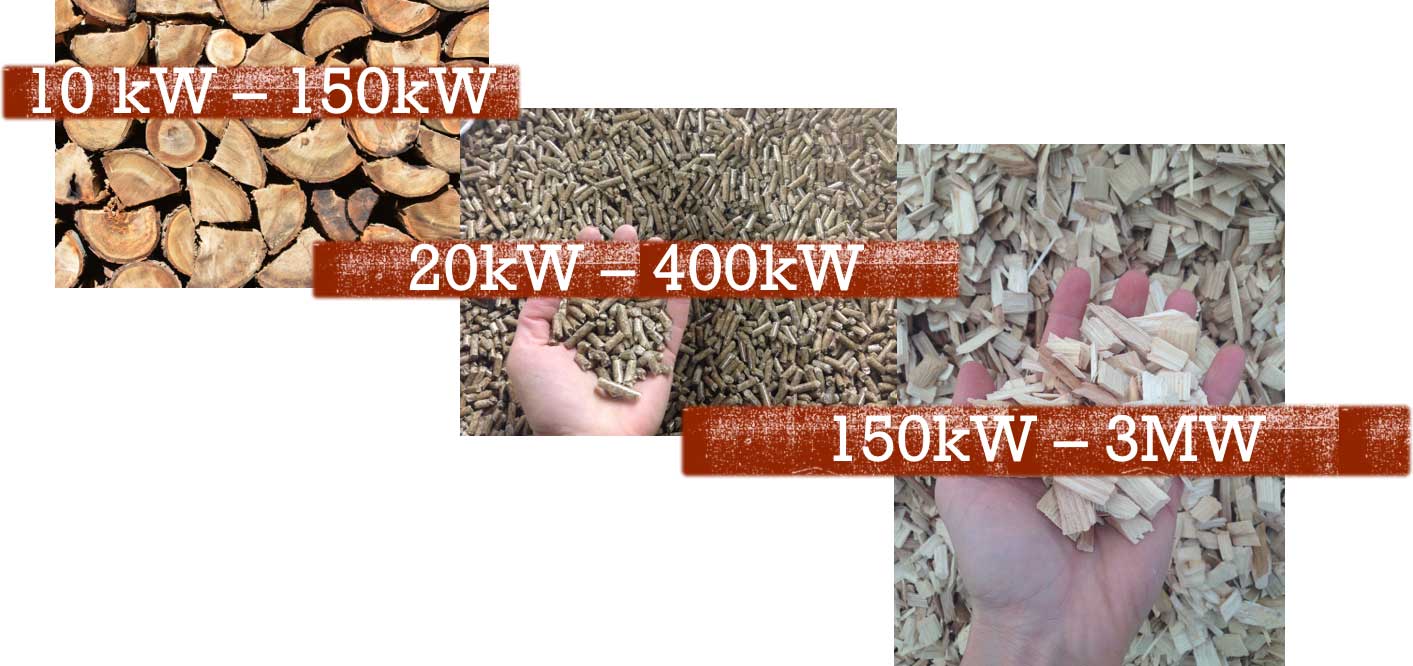Your one-stop-shop of articles, resources and answers to the burning questions.
Wood chips vs. firewood vs. wood pellets: Which is best for you?
Wood comes in many forms, species, sizes and origins. Let’s simplify the discussion to just the three wood mainstays: wood chips, wood pellets and logwood (firewood). My other resource posts will detail considerations for each fuel type but for now, let’s consider them broadly.
Each fuel type can be used only within a range of heat demand as shown in the graphic below. If you are working in BTU’s, then 1KW = 3,412 BTU.
Firewood, everyone knows and understands. You cut down a tree, cut the trunk into lengths and split it with an axe. Right now you’re picturing a dude with a plaid shirt and a moustache right? CBC’s “This is That” prepared the video linked below to poke fun at the stereotype.
Firewood handling can’t be automated. We can’t build a machine that will stack, move and load firewood into a boiler, our hands need to do that. Because of this, firewood heating is only viable for smaller heating loads: houses, small businesses, garages etc. Try to heat too much with firewood and you will need to devote full time hours cutting, splitting and loading! The big advantage of firewood is that you can harvest it yourself leading to the cheapest heating fuel possible.
If you are at all second guessing the commitment to handling firewood for your heating system, we strongly encourage you to look at pellets instead. People that heat with firewood know that’s what they want and they are eager to get at ‘er with their axes, chainsaws and plaid shirts etc.
Wood pellets are amazing. They are made to meet specifications and are very controlled, you always know what you’re getting because your supplier can provide consistent quality testing results. They are the densest form of wood fuel at 650 kg/cubic meter. They can be moved through automated pneumatic and auger systems and they can be stored easily and for a long time. You can enjoy the cost savings and carbon neutral benefit of pellets without ever actually handling them. The drawback of pellets is that, unlike firewood, you have to buy them from a manufacturer at a cost of usually around $300/ton. Still cheaper than propane, oil or electricity but not as cheap as wood chips.
Chips are the cheapest form of wood fuel that you can buy because they are easiest to produce in large quantities. You need a multi-million dollar pellet mill to make wood pellets but you just need a chipper to make wood chips. Because wood chips are bulky and don’t flow like pellets do, to use them for heating you need a robust fuel handling system which is why wood chips won’t work for smaller heat loads. If you’re looking for a wood chip heating option for your house, look at pellets instead.
Let me paint a picture: if you use a 150KW Fröling T4 boiler, it will provide enough heat for about 8 normal sized houses. It will use 50 tons of chips in a year which is equivalent to two fully loaded tractor trailer trucks. You’ll need storage area for that volume (200 cubic meters) because you can’t store energy chips outside in the rain and snow. The T4 has a robust auger system to take fuel from the storage bunker to the boiler, you can’t shrink it down for a smaller boiler. Unless you have an energy wood chip delivery service in your area (you most likely don’t unless you live within 100km of our Thunder Bay location), you’ll have to have equipment on site to handle your fuel, like a skid steer or a tractor.
Of course, if you need 150KW of heat and you have a site where storing and moving chips is easy (like most farms), then heating with wood chips will save you fistfuls of money compared to oil, propane or electricity. You can even find savings over natural gas if your chip source is cheap enough. For larger heat loads in the range of our TM500 boilers, wood chips will save literally tons of money over heating oil.

